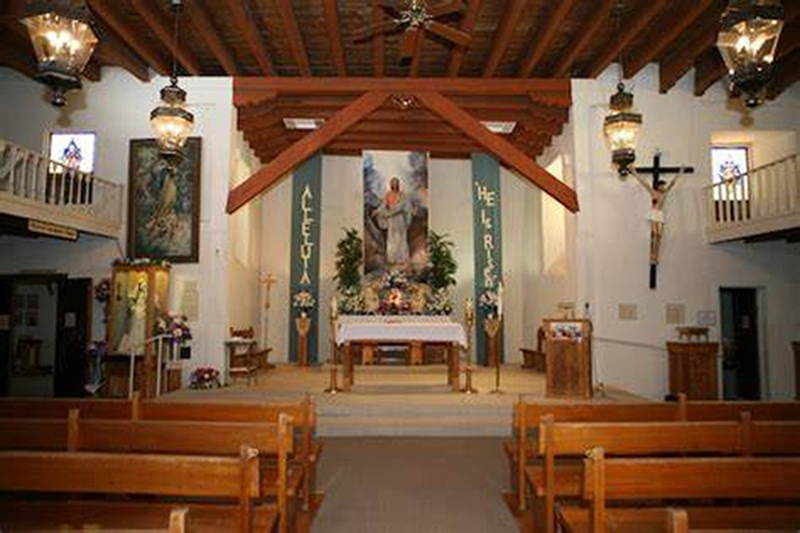la historia del Rio Abajo

Submitted photo
Interior of the Immaculate Conception Catholic Church, the scene of many weddings in Tomé.
Most of us have fond memories of our wedding days. It is usually a day full of love, joy and expectations of a wonderful married life ahead.
It is also a day full of traditional customs. Grooms dare not see their brides on the day of their weddings. Brides must wear something old, something new, something borrowed and something blue.
Although these traditions are amusing today, there was a time, not too long ago, when many other wedding traditions were popular and important in New Mexico.
As the June wedding season approaches, it is well to remember these older customs and consider why they have faded from practice and memory today.
Arranged and unarranged
A few rich, powerful families dominated New Mexico for hundreds of years. To make sure that their power and wealth remained within this upper class from generation to generation, the ricos (rich) arranged for their children to marry the offspring of equally affluent families.
Marriages could be arranged when children were only 5 or 6 years old. Once of age in their teenage years, couples often married with large, elaborate ceremonies and receptions to prove their parents’ wealth as much as to celebrate their holy union.
A fortunate few were in love before they wed. But in most arranged marriages, if it developed at all, love developed after, not before the couple’s wedding day.
Although they lacked the wealth and power of New Mexico’s small upper class, most men and women at least enjoyed love, romance and chaperoned (or unchaperoned) courting before their wedding day. Their weddings were seldom arranged, but their parents’ approval was still sought and expected in a tradition-filled society.
New Mexicans in the Spanish colonial era could marry when they were as young as 11 years old for girls and 13 for boys. Marriages at this young age were rare, but sometimes considered necessary, especially if a girl was left orphaned without a family to care for her.
Spanish colonial brides were typically young, with 25 percent of all girls married by the time they were 15. Some still played with dolls to their wedding day and later, when their husbands went to work.
The proposal letter
By at least the mid-1800s, young men who sought a young woman’s hand in marriage first discussed the matter with his own parents. If they approved of the match, they drafted a letter to propose the union in humble, affable terms to the young woman’s mother and father.
We are fortunate to have some copies of these early letters. Historian Robert Torrez has discovered several examples in the state archives in Santa Fe. One, written in Ranchitos de Taos, dates back to 1876. Others are treasured documents kept in family collections.
The letters were written in Spanish, using beautiful cursive handwriting. Their content was much the same, with only slight variations.
A typical pedir esposa (wedding proposal) was sent from Tomé on Dec. 20, 1909. Translated, it read:
Señor Don Antonio Salazar y Señora Doña Nicolasa Luhan Salazar
Greetings,
Our good relations and friendship bring to mind that we may further strengthen that friendship. You have a daughter, Maria Salazar, who is of excellent virtue, for whom our son, Juan Torrez, has indicated his love for her to be his wife and companion, according to the rules of our religion.
We have not wasted means nor ways to sow virtues and cultivate talents in our son, whom we do not pretend to praise but whom you know well. We are convinced that he is capable of establishing a home and raising a family.
We humbly request the honor of seeking this treasure, your daughter, in your family.
Please honor this request with frankness and without reservations or ill-feelings should your reply not be favorable.
Your favorable reply will fill us with honor and great joy; but if for any reason or other commitment, we will feel the sorrow from our hearts and disappointment for our son, but it will not diminish our respect and friendship.
Jose Torrez and Doloritas Romero Torrez’s pedir esposa to the Salazars contained just the right balance of respect for their daughter, respect for them (addressing them as don and doña) and praise for their own son. Their words also clearly convey the courteous message that while a “favorable reply” would fill them with “honor and great joy,” an unfavorable response would not “diminish our respect and friendship.”
The girl’s parents responded with an equally formal reply, making sure that a short time had lapsed so they — and their daughter — did not appear too eager. Their reply would include an invitation to dinner where the girl’s parents would deliver their final decision.
The young man and his parents would appear for dinner on the appointed day and time, no doubt dressed in their best attire. Everyone would sit down to eat, but there would be no discussion of the young man’s intensions. To avoid confrontation if an unfavorable response was planned, a simple code was used to convey the “verdict.”
By tradition, if a young man was served calabazas (squash) as part of the meal, his proposal was rebuffed. If the suiter was not served calabazas, his proposal was accepted. Using this accepted code, awkward confrontations were avoided in the interest of keeping the peace and not diminishing the parents’ mutual respect and ongoing friendship.
A girl’s parents could deliver a far less subtle rejection by not answering the initial letter and simply sending a whole calabaza to the suiter’s parents’ door!

Photo courtesy of Ramon Torrez
Maria and Juan Torrez married at the Immaculate Conception Catholic Church, in Tomé, in May 1910.
Traditions did not always go as planned
As in all human endeavors, this traditional method of proposal and acceptance or rejection did not always go as planned. The serving of calabazas might not be accepted as calmly or as politely as planned or expected.
After all, how could anyone reject the earnest proposal of a parents’ jito (beloved son)? Such a rejection would reflect badly not only on the son, but also on his parents.
There was also the possibility that a girl’s parents might decide to serve calabazas to a young man, contrary to the wishes of their daughter — or vice versa. The resulting friction could cause bitter feelings and division for years.
The authors of this column have their own stories about what became of their marriage proposals as young men. Needless to say, all did not go as planned once they mustered up the courage pedir esposa.
By the time Matt Baca’s father, Carlos, delivered Matt’s formal request for Theresa Gabaldon’s hand in 1959, the message was usually given verbally, rather than in writing. Matt was Carlos’s oldest son, so Carlos had never delivered a request of marriage before. Understandably nervous, Carlos started his speech to Theresa’s parents but soon faltered and forgot the words.
Fortunately, Theresa’s father, Donisio Gabaldon had four sons, had spoken these words on their behalf and knew them quite well. In a true act of kindness and respect, Donisio coached Carlos through the message, to everyone’s amusement. The families sat down to dinner and, thank goodness, Matt was spared a serving of calabazas.
Matt and Theresa married on Dec. 26, 1959. They were married for 58 blissful years, raising two sons and two daughters of their own.
Richard Melzer had his own experience with these traditions when he courted Rena Chavez in the mid-1980s. By then, formal letters regarding marriage proposals were no longer exchanged. He did, however, know enough about Hispanic culture to be taken aback when Rena’s mother, Angie Chavez, served him a large portion of calabazas at a meal one Sunday afternoon.
Knowing that Angie was famous for her pranks, Richard gently pushed the dish of calabazas away. With a straight face, Angie declared that simply because Richard had pushed the squash away did not mean that she had not served it to him, with obvious implications.
Angie finally admitted that she had played a prank and did, in fact, accept Richard’s proposal to Rena. Richard and Rena were married on March 9, 1984. Angie lived with them during the last 12 years of her prank-filled life, passing away at the age of 102 in 2020.

Photo courtesy of Jim Sloan
Old Our Lady of Belen Catholic Church, the scene of many weddings.
The rest of the story
Readers may want to know what became of Juan Torrez and Maria Salazar after Juan’s parents sent Maria’s parents their letter of intent on behalf of their son. Happily, 24-year-old Juan was not served calabazas when he and his parents dined at the Salazar home. Juan and his 21-year-old bride, Maria, married in the Immaculate Conception Catholic Church in Tomé in May 1910.
Juan and Maria would have five boys and two girls, ranging in age from 1 to 18 by 1930. Sadly, Juan died in 1930, leaving Maria to raise their children through the lean years of the Great Depression.
Juan and Maria’s grandson, Ramon Torrez, still lives and farms in Tomé.
And what became of letters of proposal? They are still used, although rarely and usually sent directly by men to women, rather than exchanged between their parents. Suggested formats are even available on the internet.
The old tradition seems to have faded by the mid-1900s as men and women increasingly moved from their parents’ homes before marriage and became more independent by the time they entered matrimony at an older age than ever before; a groom’s average age in New Mexico is now 28.8, while the bride’s average age is now 27.6.
Modern couples sometimes seek their parents’ blessing before they marry, but seldom involve their parents in the arrangement, proposal, acceptance — or rejection — process. With an increasing rate of divorce in recent years, we must wonder if the old ways were better for newlywed couples and the odds of their long-term bliss.


















